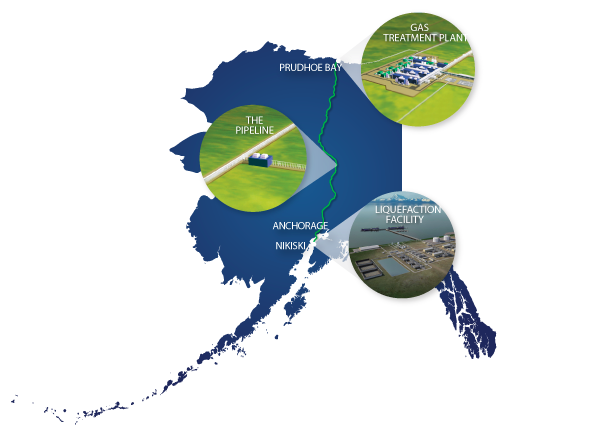Thailand is making a potential entry into the US liquefied natural gas market with a move that could significantly advance the long-planned Alaska LNG Project.
The Ministry of Energy of Thailand has instructed national energy giants PTT and Electricity Generating Public Company to begin formal discussions with the US government regarding Thai participation in LNG development in the state of Alaska, according to reporting by EnerData.com.
Representatives from Southeast Asia are expected in Alaska early next month to continue talks with state and federal representatives about the potential for Alaska LNG to be shipped to South Korea, Japan, and Thailand. Also expected at the conference and associated side meetings are Energy Sec. Chris Wright, Interior Sec. Doug Burgum, and EPA Administrator Lee Zeldin.
The talks could lead to Thailand importing between 3 to 5 million tons of LNG per year from Alaska, and would position the Southeast Asian nation as a long-term buyer in one of the most ambitious energy infrastructure ventures in North America since the Trans Alaska Pipeline System was built in the 1970s.
Alaska Gove. Mike Dunleavy, speaking at a Hudson Institute event in Washington, D.C., reaffirmed that construction on the 807-mile natural gas pipeline — a centerpiece of the $44 billion Alaska LNG project — could begin as soon as next year. A final investment decision is expected as early as this fall by the main developer, Glenfarne. Before that, the company will proceed into the Front End Engineering and Design (FEED) phase, which is the next big step. A FEED decision is expected soon.
If timelines hold, natural gas could begin flowing through the pipeline by 2028 or 2029, with LNG exports commencing from a new terminal in Nikiski two years later.
Thailand’s participation, if formalized, would likely involve direct investment in gas production, pipeline development, and LNG export infrastructure.
This includes three major components: the 1,299-kilometer pipeline from the North Slope to Nikiski; a 20 Mt/year LNG terminal; and a carbon capture and storage facility designed to sequester 7 million tons of CO₂ annually.
Involvement from PTT and EGCO could bring financial credibility to the project, while supporting Thailand’s energy diversification goals and reducing reliance on Middle Eastern and Southeast Asian gas supplies.
The move follows similar recent international interest. In March, Taiwan’s CPC Corporation signed a purchase and investment agreement with the Alaska Gasline Development Corporation, which is spearheading the project. South Korean firms have also been in talks to join.
By attracting a growing list of Asian stakeholders, the Alaska LNG project is addressing one of its primary challenges: securing long-term offtake agreements and the anchor investors needed to justify the multibillion-dollar buildout.
Dunleavy noted that a phased approach to project development is helping mitigate concerns over the scale and complexity of the venture. “You build it in pieces, finance it in stages, and align it with confirmed demand,” he said at the conference.
The project is not only a priority for Dunleavy, but is a strong priority of President Donald Trump.

O wait a minute the democrats said there was no market for our gas. You must be misinformed Suzanne.
Doug’s right. For 20 years we’ve been hearing the anti-progress progressives say there’s no market for Alaska gas. It’s like Ronald Reagan said, “The trouble with our Liberal friends is not that they’re ignorant; it’s just that they know so much that isn’t so.”
Everyone needs our gas including us.
Funny……….aren’t we soon to be importing LNG into Nikiski?
Other suppliers such as Indonesia are cheaper and closer.
Cheaper and closer are big factors, but politically stable has become the most crucial factor in energy (and everything else, frankly). The Alaska oil industry was virtually created because the Middle East began to use oil as a political weapon. Look what has happened to Russia’s oil industry. Even if we have energy that doesn’t require fuel (hydroelectric, geothermal, etc) somebody is going to try to stop it (Eklutna, Yuroks, Klamath, etc).
Trump’s economic warfare might be justified, and it might work in the short term, but in the long term, it weakens American economic dependability.
Indonesia is also 3rd world and unreliable. Reliable supply is half the battle whidby.
“Man Does Not Plan to Fail…He fails to Plan.
Here is a plan: “Drill Baby Drill, and have the state encourage oil and gas investment from all both big and small. Alaska has two operators that produce 95% of the state’s oil and gas; It is time to approve Units like the Greater Point Thomson Unit and welcome others to compete fairly so the world will not think Alaska is a company town with state-endorsed monopolies or an anti-oil and gas development state. Plan for success!
We need a smelter at point Mac to make re bar and other rough iron products if we want to get all this scrap crap scattered across our state re cycled. We need a lot of gas for that.